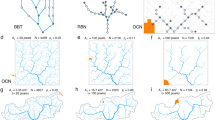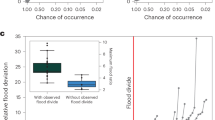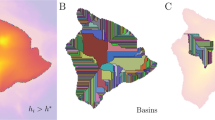Abstract
Branching river networks are one of the most widespread and recognizable features of Earth’s landscapes and have also been discovered elsewhere in the Solar System1,2. But the mechanisms that create these patterns and control their spatial scales are poorly understood. Theories based on probability3,4,5 or optimality3,6,7,8 have proven useful9, but do not explain how river networks develop over time through erosion and sediment transport. Here we show that branching at the uppermost reaches of river networks is rooted in two coupled instabilities: first, valleys widen at the expense of their smaller neighbours, and second, side slopes of the widening valleys become susceptible to channel incision. Each instability occurs at a critical ratio of the characteristic timescales for soil transport and channel incision. Measurements from two field sites demonstrate that our theory correctly predicts the size of the smallest valleys with tributaries. We also show that the dominant control on the scale of landscape dissection in these sites is the strength of channel incision, which correlates with aridity and rock weakness, rather than the strength of soil transport. These results imply that the fine-scale structure of branching river networks is an organized signature of erosional mechanics, not a consequence of random topology.
This is a preview of subscription content, access via your institution
Access options
Subscribe to this journal
Receive 51 print issues and online access
$199.00 per year
only $3.90 per issue
Buy this article
- Purchase on Springer Link
- Instant access to full article PDF
Prices may be subject to local taxes which are calculated during checkout




Similar content being viewed by others
References
Mars Channel Working Group. Channels and valleys on Mars. Geol. Soc. Am. Bull. 94, 1035–1054 (1983)
Tomasko, M. G. et al. Rain, winds and haze during the Huygens probe’s descent to Titan’s surface. Nature 438, 765–778 (2005)
Leopold, L. B. & Langbein, W. B. The concept of entropy in landscape evolution. Prof. Pap. US Geol. Surv. 500-A, 1–20 (1962)
Shreve, R. L. Infinite topologically random channel networks. J. Geol. 75, 178–186 (1967)
Howard, A. Simulation of stream networks by headward growth and branching. Geogr. Anal. 3, 29–50 (1971)
Howard, A. Theoretical model of optimal drainage networks. Wat. Resour. Res. 26, 2107–2117 (1990)
Sun, T., Meakin, P. & Jøssang, T. Minimum energy dissipation model for river basin geometry. Phys. Rev. E 49, 4865–4872 (1994)
Rigon, R., Rinaldo, A., Rodriguez-Iturbe, I., Bras, R. L. & Ijjasz-Vasquez, E. Optimal channel networks: a framework for the study of river basin morphology. Wat. Resour. Res. 29, 1635–1646 (1993)
Rodriguez-Iturbe, I. & Rinaldo, A. Fractal River Basins: Chance and Self-Organization (Cambridge Univ. Press, 2001)
Gilbert, G. K. Report on the Geology of the Henry Mountains (US Govt Printing Office, 1877)
Horton, R. E. Erosional development of streams and their drainage basins: hydrophysical approach to quantitative morphology. Bull. Geol. Soc. Am. 56, 275–370 (1945)
Willgoose, G., Bras, R. L. & Rodriguez-Iturbe, I. Results from a new model of river basin evolution. Earth Surf. Process. Landf. 16, 237–254 (1991)
Howard, A. D. A detachment-limited model of drainage basin evolution. Wat. Resour. Res. 30, 2261–2286 (1994)
Tucker, G. E. & Slingerland, R. Drainage basin responses to climate change. Wat. Resour. Res. 33, 2031–2047 (1997)
Dunne, T. Formation and controls of channel networks. Prog. Phys. Geogr. 4, 211–239 (1980)
Strahler, A. N. Quantitative analysis of watershed geomorphology. Trans. Am. Geophys. Union 38, 913–920 (1957)
Schumm, S. A. Evolution of drainage systems and slopes in badlands at Perth Amboy, New Jersey. Geol. Soc. Am. Bull. 67, 597–646 (1956)
Kirchner, J. W. Statistical inevitability of Horton's laws and the apparent randomness of stream channel networks. Geology 21, 591–594 (1993)
Berg, T. M. et al. Geologic Map of Pennsylvania (Pennsylvania Geological Survey, 1980)
Durham, D. L. Geology of the southern Salinas Valley area, California. Prof. Pap. US Geol. Surv. 819, 1–111 (1974)
Perron, J. T., Kirchner, J. W. & Dietrich, W. E. Formation of evenly spaced ridges and valleys. Nature 460, 502–505 (2009)
Montgomery, D. R. & Dietrich, W. E. Channel initiation and the problem of landscape scale. Science 255, 826–830 (1992)
Perron, J. T., Dietrich, W. E. & Kirchner, J. W. Controls on the spacing of first-order valleys. J. Geophys. Res.. 113, F04016, http://dx.doi.org/10.1029/2007JF000977 (2008)
Bonnet, S. Shrinking and splitting of drainage basins in orogenic landscapes from the migration of the main drainage divide. Nature Geosci. 2, 766–771 (2009)
Hovius, N. Regular spacing of drainage outlets from linear mountain belts. Basin Res. 8, 29–44 (1996)
Smith, T. R. & Bretherton, F. P. Stability and the conservation of mass in drainage basin evolution. Wat. Resour. Res. 8, 1506–1529 (1972)
Izumi, N. & Parker, G. Inception of channelization and drainage basin formation: upstream-driven theory. J. Fluid Mech. 283, 341–363 (1995)
Snyder, N. P., Whipple, K. X., Tucker, G. E. & Merritts, D. J. Landscape response to tectonic forcing: digital elevation model analysis of stream profiles in the Mendocino triple junction region, northern California. Geol. Soc. Am. Bull. 112, 1250–1263 (2000)
Fernandes, N. F. & Dietrich, W. E. Hillslope evolution by diffusive processes: the timescale for equilibrium adjustments. Wat. Resour. Res. 33, 1307–1318 (1997)
Mitášová, H. & Hofierka, J. Interpolation by regularized spline with tension: II. Application to terrain modeling and surface geometry analysis. Math. Geol. 25, 657–669 (1993)
Peckham, S. D. in Geomorphometry 2011 (eds Hengl, T. Evans, I. S., Wilson, J. P. & Gould, M. ) 27–30 (2011); available at http://geomorphometry.org/Peckham2011a (2011)
Lashermes, B., Foufoula-Georgiou, E. & Dietrich, W. E. Channel network extraction from high resolution topography using wavelets. Geophys. Res. Lett.. 34, L23S04, http://dx.doi.org/10.1029/2007GL031140 (2007)
Passalacqua, P., Do Trung, T., Foufoula-Georgiou, E., Sapiro, G. & Dietrich, W. E. A geometric framework for channel network extraction from lidar: nonlinear diffusion and geodesic paths. J. Geophys. Res.. 115, F01002, http://dx.doi.org/10.1029/2009JF001254 (2010)
Tarboton, D. G. A new method for the determination of flow directions and upslope areas in grid digital elevation models. Wat. Resour. Res. 33, 309–319 (1997)
Jenson, S. K. & Domingue, J. O. Extracting topographic structure from digital elevation data for geographic information system analysis. Photogramm. Eng. Remote Sensing 54, 1593–1600 (1988)
Gonzalez, R. C., Woods, R. E. & Eddins, S. L. Digital Image Processing Using MATLAB (Pearson Prentice Hall, 2004)
Dietrich, W. E. & Dunne, T. in Channel Network Hydrology (eds Beven, K. & Kirkby, M. J. ) 175–219 (Wiley & Sons, 1993)
Hack, J. T. Studies of longitudinal stream profiles in Virginia and Maryland. Prof. Pap. US Geol. Surv. 294-B, 1–97 (1957)
Tucker, G. E. & Slingerland, R. Predicting sediment flux from fold and thrust belts. Basin Res. 8, 329–349 (1996)
Culling, W. E. H. Analytical theory of erosion. J. Geol. 68, 336–344 (1960)
Culling, W. E. H. Soil creep and the development of hillside slopes. J. Geol. 71, 127–161 (1963)
Nash, D. Morphologic dating of degraded normal fault scarps. J. Geol. 88, 353–360 (1980)
Hanks, T. C., Bucknam, R. C., Lajoie, K. R. & Wallace, R. E. Modification of wave-cut and faulting-controlled landforms. J. Geophys. Res. 89, 5771–5790 (1984)
Rosenbloom, N. A. & Anderson, R. S. Hillslope and channel evolution in a marine terraced landscape, Santa Cruz, California. J. Geophys. Res. 99, 14013–14029 (1994)
Monaghan, M. C., McKean, J., Dietrich, W. & Klein, J. 10Be chronometry of bedrock-to-soil conversion rates. Earth Planet. Sci. Lett. 111, 483–492 (1992)
McKean, J. A., Dietrich, W. E., Finkel, R. C., Southon, J. R. & Caffee, M. W. Quantification of soil production and downslope creep rates from cosmogenic 10Be accumulations on a hillslope profile. Geology 21, 343–346 (1993)
Small, E. E., Anderson, R. S. & Hancock, G. S. Estimates of the rate of regolith production using 10Be and 26Al from an alpine hillslope. Geomorphology 27, 131–150 (1999)
Seidl, M. A., Dietrich, W. E. & Kirchner, J. W. Longitudinal profile development into bedrock: an analysis of Hawaiian channels. J. Geol. 102, 457–474 (1994)
Stock, J. D. & Montgomery, D. R. Geologic constraints on bedrock river incision using the stream power law. J. Geophys. Res. 104, 4983–4994 (1999)
Snyder, N. P., Whipple, K. X., Tucker, G. E. & Merritts, D. J. Channel response to tectonic forcing: field analysis of stream morphology and hydrology in the Mendocino triple junction region, northern California. Geomorphology 53, 97–127 (2003)
Seidl, M. A. & Dietrich, W. E. The problem of channel erosion into bedrock. Catena 23, 101–124 (1992)
Howard, A. D. & Kerby, G. Channel changes in badlands. Bull. Geol. Soc. Am. 94, 739–752 (1983)
Perron, J. T. & Fagherazzi, S. The legacy of initial conditions in landscape evolution. Earth Surf. Process. Landf. 37, 52–63 (2012)
Granger, D., Kirchner, J. & Finkel, R. Spatially averaged long-term erosion rates measured from in situ-produced cosmogenic nuclides in alluvial sediment. J. Geol. 104, 249–257 (1996)
Kohl, C. P. & Nishiizumi, K. Chemical isolation of quartz for measurement of in-situ-produced cosmogenic nuclides. Geochim. Cosmochim. Acta 56, 3583–3587 (1992)
Ditchburn, R. G. & Whitehead, N. E. The separation of 10Be from silicates. In Proc. Third Workshop of the South Pacific Environmental Radioactivity Association 4–7. (1994)
Balco, G., Stone, J. O., Lifton, N. A. & Dunai, T. J. A complete and easily accessible means of calculating surface exposure ages or erosion rates from 10Be and 26Al measurements. Quat. Geochronol. 3, 174–195 (2008)
Acknowledgements
This study was supported by the US National Science Foundation Geomorphology and Land Use Dynamics programme through award EAR-0951672 to J.T.P. and by the US Department of Defense through a National Defense Science and Engineering Graduate Fellowship to P.W.R. J.T.P. is a Scholar in the Canadian Institute for Advanced Research (CIFAR). The authors thank T. Clifton and G. Chmiel for assistance with sample preparation, and the Orradre family of San Ardo, California, and numerous landowners in Greene County, Pennsylvania, for granting access to their land.
Author information
Authors and Affiliations
Contributions
J.T.P. conceived of the study, performed the numerical modelling, and wrote the paper. J.T.P., P.W.R. and K.L.F. conducted the fieldwork. P.W.R. processed the 10Be samples, and P.W.R. and K.L.F. analysed the 10Be data. J.T.P. and M.L. performed the topographic analyses.
Corresponding author
Ethics declarations
Competing interests
The authors declare no competing financial interests.
Supplementary information
Supplementary Information
This file contains Supplementary Figures 1-7, Supplementary Tables 1-2, Supplementary Text and Data and Supplementary References. (PDF 4024 kb)
Rights and permissions
About this article
Cite this article
Perron, J., Richardson, P., Ferrier, K. et al. The root of branching river networks. Nature 492, 100–103 (2012). https://doi.org/10.1038/nature11672
Received:
Accepted:
Published:
Issue Date:
DOI: https://doi.org/10.1038/nature11672
This article is cited by
-
Vegetation controls on channel network complexity in coastal wetlands
Nature Communications (2023)
-
Characterization and Classification of River Network Types
Water Resources Management (2023)
-
Evolution of eastern Tibetan river systems is driven by the indentation of India
Communications Earth & Environment (2021)
-
The riverine thruway hypothesis: rivers as a key mediator of gene flow for the aquatic paradoxical frog Pseudis tocantins (Anura, Hylidae)
Landscape Ecology (2021)
-
Drainage evolution in intermontane basins at the Qinling-Daba Mountains
Science China Earth Sciences (2021)
Comments
By submitting a comment you agree to abide by our Terms and Community Guidelines. If you find something abusive or that does not comply with our terms or guidelines please flag it as inappropriate.



